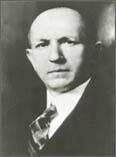
Alfred Lotka, Mathematical Demographer
Date
March 1, 2000
Author

Alfred Lotka, 1880–1949
In this Series
- Alfred Lotka, Mathematical Demographer
- Margaret Sanger, Birth Control Pioneer
- Alan F. Guttmacher, People’s Physician
- Gregory Pincus, Father of the Pill
- John D. Rockefeller 3rd, Statesman and Founder of the Population Council
- Reimert T. Ravenholt, USAID’s Population Program Stalwart
- Nafis Sadik, Architect of ICPD
This is the first in a series of profiles of the people who have most influenced thinking about population over the past century. The profiles will bring you the insights of contemporary population specialists on the contributions of their predecessors and contemporaries.
Mathematical demography is rarely used in heated political debate. But the classic 1925 article “On the True Rate of Natural Increase,” which synthesized years of work by Alfred Lotka and several collaborators, led off with a snipe at those who had just passed the most restrictive immigration law ever seen in the United States.
Lotka and Louis Dublin showed that the surplus of births over deaths in the resident American population was an artifact of a disproportionately large number of men and women in the peak ages for reproduction. The age distribution was itself the result of high rates of immigration in preceding decades. If the population of the United States, or of any other country, were “stable” — closed to migration in or out, and subject to its current schedule of age-specific birth and death rates — then it would settle down fairly quickly to an unchanging age distribution and a characteristic — in this case, surprisingly low — rate of increase. Far from worrying about the nation filling up with foreign-born “undesirables,” Lotka cautioned that Americans ought to be concerned about a declining population.
Looking for portents of decline below the surface of current trends may have come more naturally to Lotka than to his compatriots. Born in 1880, in what is now Poland, to American missionaries, he was educated in France and Great Britain, where concern with decline in the quantity and “quality” of populations bordered on the obsessive even before World War I. Lotka came to the United States in 1902 and eventually joined the Metropolitan Life Insurance company. From then on he concentrated on life tables and on his passion to bring the insights of mathematics to the problems of biology. In 1931, Lotka helped found the Population Association of America, later serving as its president.
In the view of Nathan Keyfitz, one of his most important successors, Lotka’s work on the mathematics of stable populations was “the greatest single contribution to population theory.” Despite the efforts of the exclusionists, the United States never was completely closed to immigration, nor have birth and death rates ever been fixed. Thus there never was a “stable” population exhibiting all the relations worked out by Lotka and his successors. But stable populations are useful constructs, like perfect vacuums in physics. They don’t literally exist, but with a few assumptions and approximations, we can use them to make progress on practical problems otherwise too complex to approach.
For example, stable population theory provided the basis for indirect methods of demographic estimation, which allow use of partial information and reasonable assumptions to infer levels of fertility or mortality in populations where births and deaths are not well-recorded. This has been the case in most of the world until recently. Lotka’s work was also the foundation of what we know about the importance of momentum for future population growth. As a new century begins, momentum — the effect of a young age structure — shapes the level and pattern of population growth until we reach that so-far elusive stable population.
Lotka is also well-known among biologists for one of the first mathematical models applied to ecology, the Lotka-Volterra model of interaction between a predator and a prey species. Considering just two species in an ecosystem, with basic differential equations describing population dynamics and how one species eats the other and captures its stored energy, Lotka showed how a variety of stable equilibria could be produced. The model proved a useful teaching tool and a starting point for more complex analysis.
John Haaga is director of Domestic Programs at the Population Reference Bureau.
Articles in This Series
- Alfred Lotka, Mathematical Demographer
- Margaret Sanger, Birth Control Pioneer
- Alan F. Guttmacher, People’s Physician
- Gregory Pincus, Father of the Pill
- John D. Rockefeller 3rd, Statesman and Founder of the Population Council
- Reimert T. Ravenholt, USAID’s Population Program Stalwart
- Nafis Sadik, Architect of ICPD
